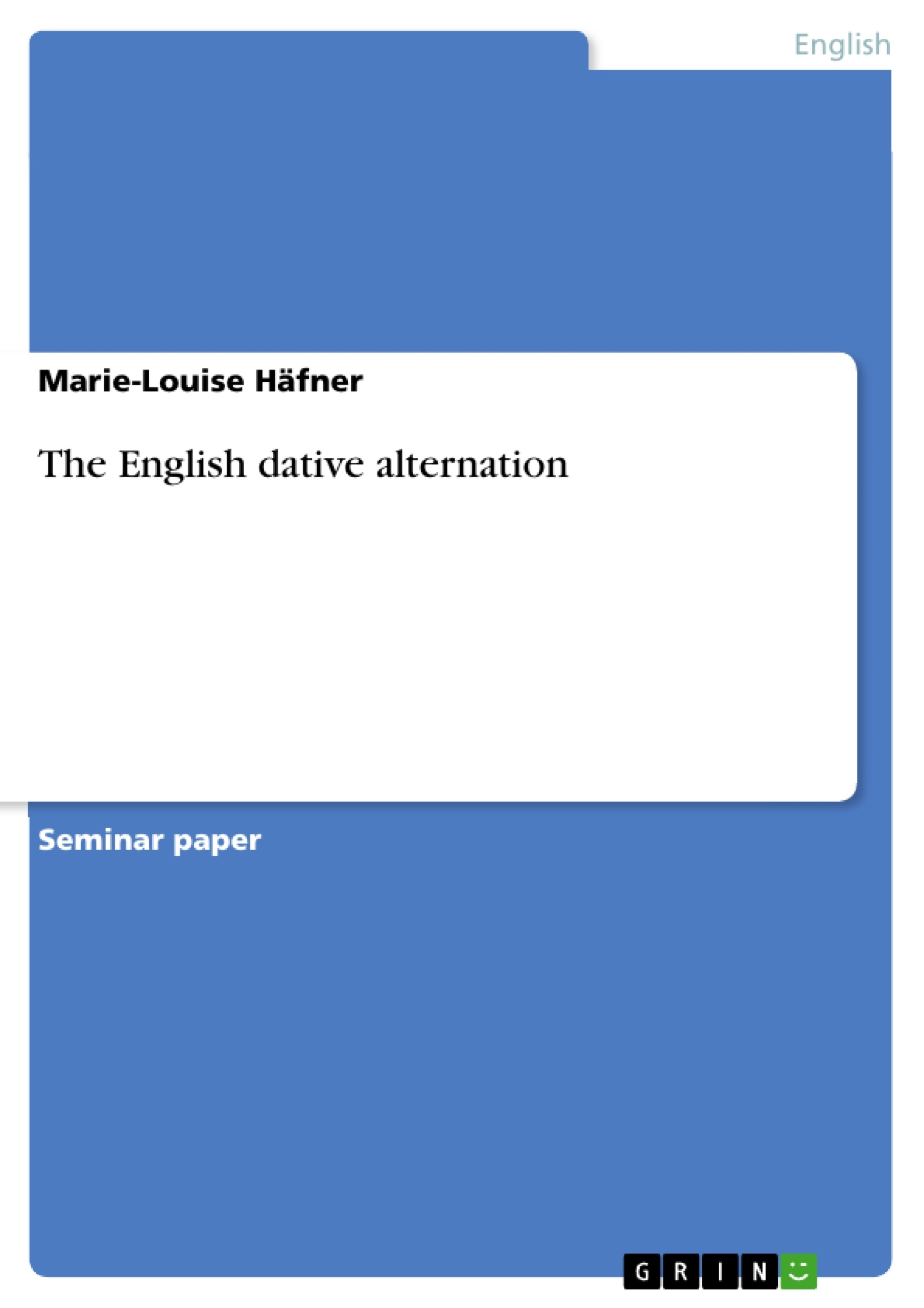Excerpt
Table of Contents
1. Introduction
2. The Dative Alternation
3. Distribution of verbs
4. Comparison between
4.1 Krifka, M. 2004 and
4.2 Rappaport Hovav, M. & Levin, B
5. Distributional differences between the Dative Alternation
in different variants of the same language
6. Conclusion
7.Bibliography
1. INTRODUCTION
Most speakers of English are unconsciously proficient in combining all kinds of information in order to form the grammatical structure they use for language production.
In this essay I attempt to describe one of these complex structures linguistically, namely the nature of dative verbs. Understanding the syntactic patterns of the verb is a challenging task – not only for the acquisition of English as a second language, but for linguistic research just as much.
We're occupied with transitive verbs that take more than one internal argument.There is a great number of alternations in English grammar which do not involve a change in the transitivity of the verb (Levin 1993), one of them being the Dative Alternation, which will be the topic of this essay.
I will begin by introducing some general findings of research in this field whereupon a list of verbs will follow which presents groups of verbs that do or do not perform the alternation.
At the core of my dissertation I will compare two different approaches on the subject, namely the works of Manfred Krifka and Rappaport Hovav & Levin. They represent two sites of the debate concerning the semantics of the dative alternation. Whilst the former defends the so-called polysemy view, the latter are enthusiastic for the single meaning approach. I will go into more detail in section 4.
In the final analysis I'm going to introduce a brief study of the dative alternation in different variants of English, namely British, Australian and American English.
2. THE DATIVE ALTERNATION
The term 'dative alternation' arises from the studies of argument structure and is used to refer to two morphosyntactic argument realization options for dative verbs (Levin 2008). In English these two syntactic patterns are called double object construction and prepositional indirect-object-construction - by me in the following referred to as to- construction.
(1) Eric gave Marie the chocolate cupcake. Double Object Construction
NP0 V NP1 NP2
Eric gave the chocolate cupcake to Marie. To-construction
NP0 V NP2 to NP1
(2) Nora threw Elias the pillow. DOC
Nora threw the pillow to Elias. To-construction
(3) Belli sent Simon a letter. DOC
Belli sent a letter to Simon. To-construction
Following Krifka's denotation (Krifka 2004) NP0 here indicates the initiator of an action, NP2 an object which is moved in location or changes possession and NP1 a recipient or goal of the respective action. As illustrated in the examples above the NP that is the object of the preposition to in the prepositional frame (Marie) is displayed as the first object in the double object construction.
It is interesting to note that not all languages show the dative alternation, even those which are closely related to English. In German for instance NP1 is set in the accusative case.
Analyses have shown that there are certain kinds of verbs that allow either one or both of the two constructions. I will go into further details on these groups in section 3.
Various research has been done on the topic, especially analysing the question of what brings forth the alternation.
Furthermore there are different opinions concerning the question whether the two variants show distinct semantic properties. Krifka arranged the three predominant views as follows:
(a)The Monosemy View
According to scholars such as Larson (1988), Aoun and Li (1989) and Butt et al. (1997) both constructions have the exact same meaning. Those accounts only differ in deciding which form derived from the other (if at all).
(b) The Polysemy View/ Have-Goal Approach
As proposed in studies by Pinker (1989), Goldberg (1995) and Pesetzky (1994) the meaning of the respective phrase expressed either in the double object construction or the to-construction do show semantic differences. Each is associated with its own meaning and gives ruse to ts own realization of arguments (Beck & Johnson 2004). Using example sentence (1) Eric gave Marie the chocolate cupcake conveys that 'Eric causes Marie to have the chocolate cupcake', meaning that there is a change of possession between the two objects. The to -construction on the other hand expresses 'Eric caused the chocolate cupcake to go to Marie', thus stresses a spatial change; or put differently – motion towards a goal. As one can see the meanings are closely related as well, but the polysemy view claims that as differences show up, certain verbs might only be consistent with one meaning.
(c) The Information Structure View
In contrast to the polysemy view defenders of the information structure approach hold that potential finely nuanced semantic distinctions are not what makes the difference in the end. Researchers such as Ereschik-Shir (1979), Rappaport&Levin (2008) and Arnold et al (2000) believe that the two variants differ only according to information-structural principles; these being:
- pre-mentioned material comes before new material
- heavy phrases come last.
(4) Anna sent her a present.
*Anna sent a present to her.
(5) *Anna sent Lara it.
Anna sent it to her.
These examples are proof to the theory, since pronouns normally provide old information. The same holds for NPs which are preceded by an definite article.
[...]
- Quote paper
- Marie-Louise Häfner (Author), 2013, The English dative alternation, Munich, GRIN Verlag, https://www.grin.com/document/272007
Publish now - it's free






















Comments